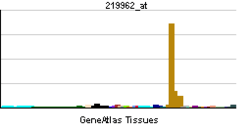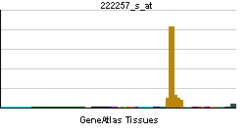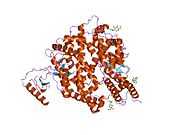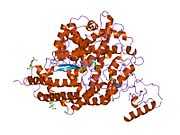Angiotensin-converting enzyme 2
AngiotensinI-converting enzyme 2 (ACE 2) is an exopeptidase that catalyses the conversion of angiotensin I to the nonapeptide angiotensin[1-9],[1] or the conversion of angiotensin II to angiotensin 1-7.[2] ACE 2 has direct effects on cardiac functiona, and is expressed predominantly in vascular endothelial cells of the heart and the kidneys.[3]
ACE 2 is the receptor for SARS virus.[4]
See also
- Renin-angiotensin system
- ACE inhibitors
References
- ↑ Donoghue M, Hsieh F, Baronas E, Godbout K, Gosselin M, Stagliano N, Donovan M, Woolf B, Robison K, Jeyaseelan R, Breitbart RE, Acton S (2000). "A novel angiotensin-converting enzyme-related carboxypeptidase (ACE2) converts angiotensin I to angiotensin 1-9". Circ. Res. 87 (5): E1–9. PMID 10969042.
- ↑ Keidar S, Kaplan M, Gamliel-Lazarovich A (2007). [_ http://cardiovascres.oxfordjournals.org/cgi/content/full/73/3/463 "ACE2 of the heart: From angiotensin I to angiotensin (1-7)"]. Cardiovasc Res. 73 (3): 463–9. doi:10.1016/j.cardiores.2006.09.006. PMID 17049503.
- ↑ Boehm M, Nabel EG (2002). "Angiotensin-converting enzyme 2--a new cardiac regulator". N. Engl. J. Med. 347 (22): 1795–7. doi:10.1056/NEJMcibr022472. PMID 12456857.
- ↑ Kuba, K., Imai, Y., Rao, S., Gao, H., Guo, F., Guan, B., ... & Penninger, J. M. (2005). A crucial role of angiotensin converting enzyme 2 (ACE2) in SARS coronavirus–induced lung injury. Nature medicine, 11(8), 875-879. doi:10.1038/nm1267
Further reading
- Turner AJ, Tipnis SR, Guy JL et al. (2002). "ACEH/ACE2 is a novel mammalian metallocarboxypeptidase and a homologue of angiotensin-converting enzyme insensitive to ACE inhibitors". Can. J. Physiol. Pharmacol. 80 (4): 346–53. doi:10.1139/y02-021. PMID 12025971.
- Turner AJ, Hiscox JA, Hooper NM (2004). "ACE2: from vasopeptidase to SARS virus receptor". Trends Pharmacol. Sci. 25 (6): 291–4. doi:10.1016/j.tips.2004.04.001. PMID 15165741.
- Katovich MJ, Grobe JL, Huentelman M, Raizada MK (2005). "Angiotensin-converting enzyme 2 as a novel target for gene therapy for hypertension". Exp. Physiol. 90 (3): 299–305. doi:10.1113/expphysiol.2004.028522. PMID 15640278.
- Ferrario CM, Trask AJ, Jessup JA (2006). "Advances in biochemical and functional roles of angiotensin-converting enzyme 2 and angiotensin-(1-7) in regulation of cardiovascular function". Am. J. Physiol. Heart Circ. Physiol. 289 (6): H2281–90. doi:10.1152/ajpheart.00618.2005. PMID 16055515.
- Jia HP, Look DC, Hickey M et al. (2006). "Infection of human airway epithelia by SARS coronavirus is associated with ACE2 expression and localization". Adv. Exp. Med. Biol. Advances in Experimental Medicine and Biology 581: 479–84. doi:10.1007/978-0-387-33012-9_85. ISBN 978-0-387-26202-4. PMID 17037581.
|chapter=ignored (help) - Lazartigues E, Feng Y, Lavoie JL (2007). "The two fACEs of the tissue renin-angiotensin systems: implication in cardiovascular diseases". Curr. Pharm. Des. 13 (12): 1231–45. doi:10.2174/138161207780618911. PMID 17504232.
- Raizada MK, Ferreira AJ (2007). "ACE2: a new target for cardiovascular disease therapeutics". J. Cardiovasc. Pharmacol. 50 (2): 112–9. doi:10.1097/FJC.0b013e3180986219. PMID 17703127.
- Dean RG, Burrell LM (2007). "ACE2 and diabetic complications". Curr. Pharm. Des. 13 (26): 2730–5. doi:10.2174/138161207781662876. PMID 17897017.
- Tipnis SR, Hooper NM, Hyde R et al. (2000). "A human homolog of angiotensin-converting enzyme. Cloning and functional expression as a captopril-insensitive carboxypeptidase". J. Biol. Chem. 275 (43): 33238–43. doi:10.1074/jbc.M002615200. PMID 10924499.
- Donoghue M, Hsieh F, Baronas E et al. (2000). "A novel angiotensin-converting enzyme-related carboxypeptidase (ACE2) converts angiotensin I to angiotensin 1-9". Circ. Res. 87 (5): E1–9. PMID 10969042.
- Vickers C, Hales P, Kaushik V et al. (2002). "Hydrolysis of biological peptides by human angiotensin-converting enzyme-related carboxypeptidase". J. Biol. Chem. 277 (17): 14838–43. doi:10.1074/jbc.M200581200. PMID 11815627.
- Crackower MA, Sarao R, Oudit GY et al. (2002). "Angiotensin-converting enzyme 2 is an essential regulator of heart function". Nature 417 (6891): 822–8. doi:10.1038/nature00786. PMID 12075344.
- Harmer D, Gilbert M, Borman R, Clark KL (2003). "Quantitative mRNA expression profiling of ACE 2, a novel homologue of angiotensin converting enzyme". FEBS Lett. 532 (1–2): 107–10. doi:10.1016/S0014-5793(02)03640-2. PMID 12459472.
- Strausberg RL, Feingold EA, Grouse LH et al. (2003). "Generation and initial analysis of more than 15,000 full-length human and mouse cDNA sequences". Proc. Natl. Acad. Sci. U.S.A. 99 (26): 16899–903. doi:10.1073/pnas.242603899. PMC 139241. PMID 12477932.
- Donoghue M, Wakimoto H, Maguire CT et al. (2004). "Heart block, ventricular tachycardia, and sudden death in ACE2 transgenic mice with downregulated connexins". J. Mol. Cell. Cardiol. 35 (9): 1043–53. doi:10.1016/S0022-2828(03)00177-9. PMID 12967627.
- Clark HF, Gurney AL, Abaya E et al. (2003). "The secreted protein discovery initiative (SPDI), a large-scale effort to identify novel human secreted and transmembrane proteins: a bioinformatics assessment". Genome Res. 13 (10): 2265–70. doi:10.1101/gr.1293003. PMC 403697. PMID 12975309.
- Li W, Moore MJ, Vasilieva N et al. (2003). "Angiotensin-converting enzyme 2 is a functional receptor for the SARS coronavirus". Nature 426 (6965): 450–4. doi:10.1038/nature02145. PMID 14647384.
- Wong SK, Li W, Moore MJ et al. (2004). "A 193-amino acid fragment of the SARS coronavirus S protein efficiently binds angiotensin-converting enzyme 2". J. Biol. Chem. 279 (5): 3197–201. doi:10.1074/jbc.C300520200. PMID 14670965.
- Towler P, Staker B, Prasad SG et al. (2004). "ACE2 X-ray structures reveal a large hinge-bending motion important for inhibitor binding and catalysis". J. Biol. Chem. 279 (17): 17996–8007. doi:10.1074/jbc.M311191200. PMID 14754895.
| |||||||||||||





